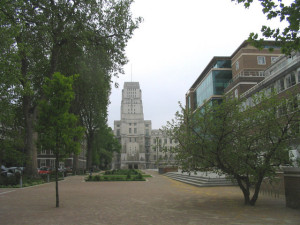The continuous day-and-night occupation with no break at week-ends or holiday times, made routine maintenance difficult.
This year’s Bloomsbury Festival takes as a theme the idea of subverting the Ministry of Information as a Ministry of Communication. We talked in detail about this theme in an earlier post (The Ministry of Communication at #BloomsburyFest 2013). This post, the last in a line where we dip into the archives held at the Senate House Library, focuses on the end of the war, and on the process of the Ministry of Information leaving the university buildings, and the academics returning.
Congratulations to the King
When the Second World War ended the University of London sent the following message to George VI (recorded in the Senate Minutes for 20 June and 18 July 1945):
“We, the Chancellor, Vice-Chancellor, Court, Senate, Graduates, and Students of the University of London, Your Majesty’s most dutiful and loyal Subjects, desire respectfully to convey to Your Majesty our whole-hearted congratulations on the victorious conclusion of the War in the Far East thus bringing to completion the defeat of the armed forces of the aggressor nations and heralding the re-establishment of peace throughout the world. In tendering our congratulations we venture to re-affirm to Your Majesty our most loyal devotion to the Thorne.”
Thanks and relief continued, but so also begun the torturous road to re-establishing the University in its own buildings as the Ministry of Information prepared the way for its exit.
Moving out of Senate House

SOAS and Senate House
With peace officially reinstated the Ministry of Information prepared itself to move out of its premises in Senate House. The Senate Minutes note that “the Ministry of Information had agreed to release the second and third floors of the Senate House by the end of October and that it was hoped that the Administrative Staff would return there from Richmond some time in November”. In addition the Senate House basement was expected (but not confirmed) to be released at the same time. Other parts of the Senate House building – such as the ground and first floors and the wing held by the Institute of Historical Research – were still to be agreed and confirmed. The second floor of the Institute of Education (home of the School of Slavonic Studies) and the fourth, fifth and sixth floors would be released by the end of October and November respectively. The Ministry expected that their removal from the Student’s Union Huts would be complete by the end of the year.
Library re-opened, books returned
The University Library was reopened to the public in August 1945 and books returned from storage in Cambridge and Oxford. A year later the Library received thanks from the Ministry for their “unfailing and generous help during the past six years”. Furthermore the Director of the Reference Division of the Ministry, Stephen Heald added:
“…may I give expression to the deep debt of gratitude which the Ministry in general (though I am not entitled to speak for it as a whole) and my own Division in particular owe to your Library, both to its invaluable resources and its highly efficient and helpful personnel. Without your help our task would have been rendered almost impossible.”
Wear and tear at Senate House
Plans were now afoot to renovate the University rooms and to work out what needed repair, replacement, or to find out what had gone missing during the seven year occupation of university buildings by the Ministry.
In general all the work carried out on the University Bloomsbury buildings had been done by maintenance staff, almost all of whom had been employed before the war. The only exceptions were four air-raid shelters constructed by the Ministry of Works. The extent of this additional wartime work was exceptional. An example is given in the minutes of the Senate Committee for 1946 that a total of 32,825 electric lamps had been used, much larger an amount than normal. Damage and natural deterioration also increased – 526 house telephones were repaired during the war-period, compared with the figure of 32 for the three years pre-war. The report noted that:
“The continuous day-and-night occupation with no break at week-ends or holiday times, made routine maintenance difficult. Noticeable examples are the air-conditioning plant, which has never been shut down since 1939, and the main switchgear for lighting and power circuits on which inspection and overhaul has been deferred”.

Model of Senate House
In addition the University hired Hampton and Sons Ltd to carry out a detailed survey of all Senate House rooms listing dilapidations and missing items. The survey occurred in May 1947 and amongst the many items recorded as missing were the scale model of the University of London that had been last recorded in the 1st Floor service room adjacent to the Senate Room; and from the lobby a framed diagram of Senate House; various oil paintings including those of George Grote; Sir John J. Shaw Lefevre; Sir G. Jessel; and Robert Low – all prominent academics connected with the University in various ways; and from the basement a portable wireless set and a timepiece in an oak case. There were numerous other items, most of which were quite mundane including missing or damaged chairs, worn carpets, damaged furniture and missing stationary.
This is the last of our quick look at the archives surrounding the Ministry of Information at Senate House. For more check out our exhibition during the Bloomsbury Festival or attend one of the many events discussing the history of this building, the Ministry, and Bloomsbury in general, amongst much else. Check out our Festival Highlights post for details of events or click on the links below for a full schedule and to keep up with news and updates.
The Bloomsbury Festival runs from October 15-20, 2013. The full schedule of events at the School of Advanced Study is available here. We are also running a series of exciting competitions in October. Follow us on @SASNews for festival news and updates.
Finding the Ministry of Communication:
Senate House, Malet Street, London

